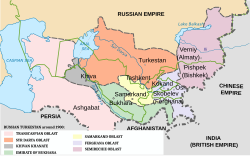West Turkistan
| Russian Turkestan Русский Туркестан |
||||||
| Governorate-General of Russian Empire | ||||||
|
||||||
|
||||||
| Provinces of Russian Turkestan in 1900 | ||||||
| Capital | Tashkent | |||||
| History | ||||||
| • | Established | July 11, 1867 | ||||
| • | Disestablished | April 30, 1918 | ||||
| Area | ||||||
| • | (1897) | 1,707,003 km2(659,078 sq mi) | ||||
| Population | ||||||
| • | (1897) | 5,280,983 | ||||
| Density | 3.1 /km2 (8 /sq mi) | |||||
| Political subdivisions | Oblasts: 5 (since 1899) | |||||
Russian Turkestan (Russian: Русский Туркестан, Russkiy Turkestan) was the western part of Turkestan within the Russian Empire (administered as a Krai or Governor-Generalship), comprising the oasis region to the south of the Kazakh steppes, but not the protectorates of the Emirate of Bukhara and the Khanate of Khiva.
Although Russia had been pushing south into the steppes from Astrakhan and Orenburg since the failed Khivan expedition of Peter the Great in 1717, the beginning of the Russian colonial conquest of Turkestan is normally dated to 1865. That year the Russian forces took the city of Tashkent under the leadership of General Mikhail Chernyayev expanding the territories of Turkestan Oblast (part of Orenburg Governorate-General). Chernyayev had exceeded his orders (he only had 3,000 men under his command at the time) but Saint Petersburg recognized the annexation in any case. This was swiftly followed by the conquest of Khodzhent, Dzhizak and Ura-Tyube, culminating in the annexation of Samarkand and the surrounding region on the Zeravshan River from the Emirate of Bukhara in 1868 forming the Zeravsh Special Okrug of Turkestan.
An account of the Russian conquest of Tashkent was written in "Urus leshkerining Türkistanda tarikh 1262-1269 senelarda qilghan futuhlari" by Mullah Khalibay Mambetov.
...
Wikipedia



